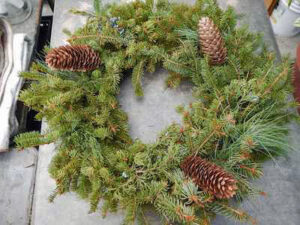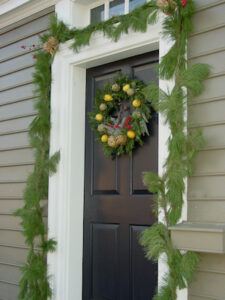Keeping Holiday Spirits Bright With Festive Greenery
by Elizabeth Cornell Fake, Fairfax Master Gardener
 Since ancient times, festive greenery has been a part of holiday celebrations to ward off the dark evil spirits of winter and to represent hope for the return of spring. Putting up holiday greenery is such a strong tradition, and most of us are in a rush to put it up and keep it alive, if possible, for the duration of the holiday season. Here are some guidelines to make the most of your indoor holiday decorations and some tips for keeping them as fresh as possible until the New Year.
Since ancient times, festive greenery has been a part of holiday celebrations to ward off the dark evil spirits of winter and to represent hope for the return of spring. Putting up holiday greenery is such a strong tradition, and most of us are in a rush to put it up and keep it alive, if possible, for the duration of the holiday season. Here are some guidelines to make the most of your indoor holiday decorations and some tips for keeping them as fresh as possible until the New Year.
Buy
With all the wreaths and garlands available in garden centers, grocery stores and tree lots, there is a strong temptation to buy decorations, bring them home, add ribbons and bows and simply put them into place. It is expensive, but it is a good way to make sure you will have beautifully designed greenery without a lot of work. In addition to the cost outlay, remember the component materials are harvested as early as August, and no one knows how old the pieces can be. Although they are kept in cold storage, without constant hydration, there is no guarantee they won’t dry out long before January 1.
Build
It is a lot more work to make your own decorations, and there is some trial and error in learning the mechanics of putting wreaths and boughs together. But, if the materials are handled correctly, you can be sure you will have fresh greens imparting their wonderful spicy scent throughout your home for the whole holiday season.

Combination of arborvitae, holly and cryptomeria wreath
Select
In Virginia, we are lucky to have many types of greenery to use in holiday decorations. Popular materials include Boxwood (Buxus), Cedars (Cedrus), Firs (Abies), Holly (Ilex), Junipers (Juniperus), Magnolia, Mountain Laurel (Kalmia latifolia), Pine (Pinus), Smilax and Spruce (Picea). Less popular but equally attractive evergreens include Arborvitae (Thuja), Cryptomeria, Hemlock(Conium maculatum), Gold Mop Cypress (Chamaecyparis pisifera), Leyland Cypress (Cupressus x leylandii), Privet (Ligustrum), Nandina, Pittosporum and Podocarpus.
For indoor use, Pines, Firs and Cedars hold their needles best and dry out slowly when exposed to interior temperatures. Although spruce is a popular choice, it sheds needles quickly and will last longer if used outdoors. Before you start cutting, take an inventory and measurements of all the places you want to decorate including front doors and entrances, staircases, doorways, window ledges, mantle pieces, hearths, niches and corners. The estimate should give you a good idea of how much greenery you will need.

Material for the wreath
Collection
Many people collect holiday greenery from their own shrubs and trees which makes it possible to keep the greens fresh and alive until needed. Prune judiciously to maintain the balance and shape of the plant. For a refresher on pruning, check the References Section below for an article on pruning evergreens. If you plan to collect greenery from woodlands or public areas, be sure to check ahead of time to see if it is permissible. Generally, you can cut on either side of a public highway, but not the median strip. Here are some other tips for collecting greens:
- Use sharp pruners, making a clean, diagonal cut across the branch.
- Crush stems of woody plants to permit uptake of water.
- Plunge stems into a bucket of water as soon as they are cut and keep in water overnight.
- When ready to use, dry the greenery thoroughly and spray with an anti-transpirant product to lock in moisture. You can use either a commercial product or make your own spray solution by mixing one tablespoon of pine-oil cleaner to a gallon of water.
- Keep greenery outdoors and out of the sunlight until ready to use.
Wreaths, garlands and swags are the perennial favorites of holiday greenery, and all are easy to assemble.
Wreaths
For best results, use a wreath form available from a craft or hobby store. Some good selections to support holiday greens are wire, grapevine or straw. Although wreath forms come in many sizes, an 18-inch form is a good size for a front door or mantle. Use 6 to 8 inch pieces of greenery to cover the form, and wire to the wreath form using a 22 or 24 gauge floral wire. Use a pair of sturdy pliers to bend the wire into place to prevent exposure of blunt ends. A glue gun with hot glue can be used to secure pieces to a straw wreath and make the joining invisible. Overlay the first layer of greenery with a second layer and possibly a third layer to add fullness. Add some other evergreen plant parts such as berries, seed pods, cones, and dried flowers to give the wreath interest. Don’t forget the ribbons or bows to complete the design. Use a double loop of wire on the back of the wreath to attach it to a door or wall.

Pine garland
Garlands
These are very popular for mantle and staircase decorating and are very easy to assemble. As long pieces of greenery can dry out very quickly, make sure they are fresh before assembly and keep outdoors if possible before bringing them inside. A good way to test freshness is to bend the needles to see if they are still flexible. If the greenery is brown or dry, find some fresher pieces. Depending on the length needed for the garland, secure several 3 to 4 foot pieces together with 20 or 22 gauge floral wire. Overlap the pieces and wire into place. Use as much wire as needed to keep the pieces securely fastened together. Add other evergreen plant parts and ribbon to add interest. Bring the garland inside and use wire or twine to hold the garland in place.
Swags
Often the best decoration for doorways, swags should be made of lightweight, flexible greenery such as pine. Pine garland has a long-lasting needle retention. Assemble in the same way as a garland wiring 3 to 4 foot pieces together using only one layer of material. Add decorative plant materials and ribbons. Hang from doorways using small cup holder hardware or invisible push pins.
Use any leftover greenery to decorate corners, niches and potted plants. Try to keep greens out of direct sunlight, away from heating vents, and check every few days for freshness. If possible, replace dry pieces with extra greenery kept in water outside for replacement. Although many people use candles with greenery, a better and more modern solution is to incorporate battery powered candles into holiday designs. Enjoy your handiwork, learn from your challenges and begin planning now for next year!
References
• Holiday Decorating With Fresh Greenery, Barbara H. Smith, Home & Garden Information Center,
Clemson Extension
• A Guide to Successful Pruning , Pruning Evergreen Trees, Susan C. French and Bonnie Lee Appleton,
Virginia Cooperative Extension, 430-457